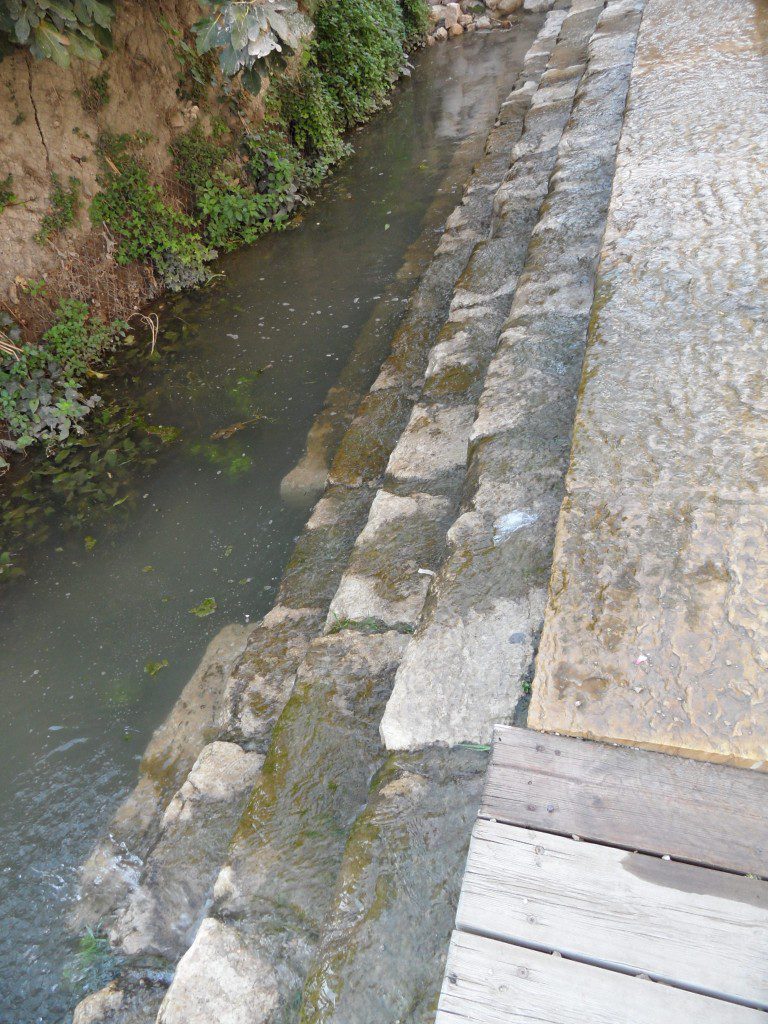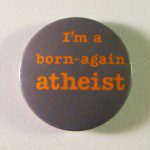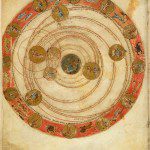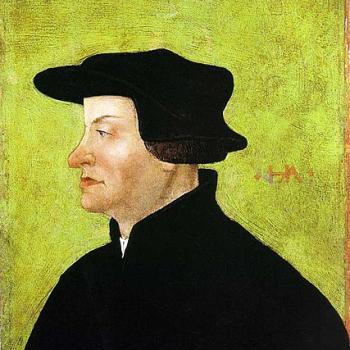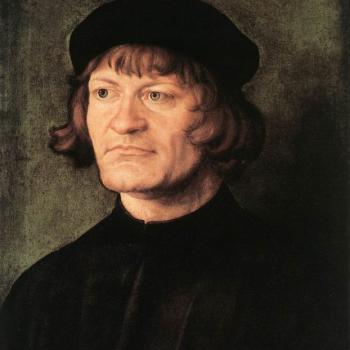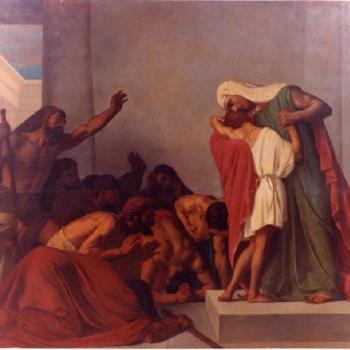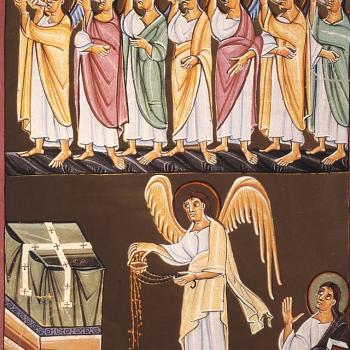+ An Examination of Fine Distinctions of Relic Classes
The Pool of Siloam in the City of David in Jerusalem (ancient Jerusalem). Here, Jesus healed the blind man. On the day we visited it, we were told that the water from the Gihon Spring was flowing into the pool for the first time (see it flowing, above) since the Temple was destroyed in 70 AD (!!!). It also stopped when we were there. [photograph by my wife Judy Armstrong, October 2014]
* * * * *
On my pilgrimage to Israel in October 2014, I touched my wedding ring to all the holy sites I visited: according to the Catholic theology of relics and veneration of same, as conduits of grace. But upon researching particulars about the three classes, I (curiously) discovered different things. The Church (somewhat unfortunately) has not made hard-and-fast statements about it. Here is what Fr. John A. Hardon, Modern Catholic Dictionary (“Relic”) says:
Relics are of three classes: the first is part of the saint’s body and is the type placed in the altar stone; the second is part of the clothing or anything used during the saint’s life; and the third is any other object, such as a piece of cloth, that has been touched to a first-class relic.
According to this very trustworthy catechist, a third-class relic has to be touched to a saint’s actual body: a first-class relic (which I never did on my pilgrimage). He precludes touching a second-class relic to create a third-class relic. But others disagree. For example, the Marian Research Institute of Dayton, Ohio, states: “Bits of cloth that have been touched to an actual first or second class relic are called third class relics.”
Rev. John Trigilio, Jr., Rev. Kenneth Brighenti, in their 2010 book, Saints for Dummies (p. 241) agree: “. . . touched to a first- or second-class relic.”)
The material of a third-class relic need not be confined to cloth, as Fr. Hardon notes. Fr. William Saunders, a great teacher, operates with a broader definition of both first- and third-class relics (even categorizing some ostensible 3rd-class relics as 2nd-class):
First class or real relics include the physical body parts, clothing and instruments connected with a martyr’s imprisonment, torture and execution. Second class or representative relics are those which the faithful have touched to the physical body parts or grave of the saint.
A Corpus Dei page follows Fr. Hardon’s scheme of third-class relics; however, it widens first-class relics in some cases as follows:
An exceptional position of this scheme hold the biblical relics, those objects that are connected to Jesus Christ and Mary directly. They are first class too. Objects in this category are the cross relics, the passion relics, that played a role in the Passion of Christ in His last days of His life.
By this criterion, my ring is a third-class many times over, since it has touched many objects directly connected with both Jesus and Mary. Joan Carroll Cruz, in her 1984 book, Relics, concurs with this to some extent, arguing (p. 2) that “the instruments of Our Lord’s Passion” are first-class relics, and that third-class relics can be touched to second-class relics as well as first-class.
Thus, depending on whom one believes, my ring is or is not a legitimate third-class relic. Even if it isn’t, it was touched to sites and objects whose veneration as holy places, shrines, and objects the Church clearly does condone and encourage (along with the sincere, well-intended piety and devotion of such acts), so at the very least one might say that my ring is now an “extraordinary sacramental item” if not technically a form of relic. That said, here are the 100 things and sites that my ring touched (with a convenient index at the end), in chronological order:
1. Elijah’s cave on Mt. Carmel.
2. Place of Elijah’s confrontation with the false prophets of Baal on Mt. Carmel.
3. The “audience hall” (Acts 25:23) during St. Paul’s trial, in Caesarea on the Mediterranean, where he appeared before King Agrippa.
4. Glass over the actual spot of Jesus’ transfiguration on Mt. Tabor.
5. 4th c. Byzantine church on Mt. Tabor (transfiguration).
6. Cana, wedding at a house in.
7. House of Mary, Joseph, and Jesus in Nazareth (steps to).
8. Mary’s Annunciation: pillar and rocks close nearby.
9. Ground of the Sermon on the Mount.
10. Feeding of the 5000: olive press on the site.
11. 1st c. mosaic tile of the church at the feeding of the 5000 location.
12. Peter’s house in Capernaum.
13. Early churches built over Peter’s house in Capernaum.
14. Synagogue in Capernaum where Jesus preached.
15. Sea of Galilee: location where Jesus appeared after His Resurrection and ate fish.
16. Sea of Galilee (water of).
17. Steps leading to the church (see #15), that Jesus and the disciples walked on.
18. Rock at the spot where Jesus healed the woman with a hemorrhage, who touched His garment: one mile from Capernaum.
19. River Jordan near where Jesus was baptized; also close to where Joshua and his armies miraculously crossed (Josh 4:1-24), and where Elijah (2 Ki 2:8) and Elisha (2 Ki 2:14) parted the waters of the river.
20. The rock Jesus sat upon when He was tempted by the devil in the wilderness.
21. Icons in the Greek Orthodox monastery on the Mount of Temptation.
22. Hermit cave in the Greek Orthodox monastery on the Mount of Temptation.
23. Road from Jericho to Jerusalem through the rugged “hill country of Judea” that both Abraham and Jesus walked. Jesus told the parable of the Good Samaritan there.
24. Mountain where Jesus commissioned Peter to lead His Church in Caesarea Philippi (Matthew 16).
25. Path that Jesus and disciples walked near Caesarea Philippi.
26. Road to Damascus that Paul took.
27. Place of the feeding of the 4000 on the eastern shore of the Sea of Galilee (Mt 12:32).
28. 5th c. monastery on the site of the Gadarenes and casting out the demon into the swine.
29. Spot where Jesus was born in Bethlehem.
30. Jesus’ Manger in Bethlehem.
31. Cave where Jesus was born in Bethlehem.
32. St. Jerome’s cave next to the cave of the nativity in Bethlehem.
33. Room where St. Jerome wrote the Vulgate Bible in Bethlehem.
34. Shepherd’s field, where they heard the angels on Christmas, in Bethlehem.
35. Shepherd’s cave in Bethlehem, where they kept their sheep.
36. Arch upon entering the church in Bethlehem.
37. Grotto of the holy innocents in Bethlehem.
38. Location of angel warning Joseph to escape to Egypt.
39. Grotto of the Three Wise Men.
40. Slab where Jesus’ dead body was lain and anointed by Mary Magdalene and Mary mother of Joses and James.
41. Rock of Golgotha, where Jesus was crucified.
42. Altar at Golgotha.
43. Rock in front of the tomb, rolled away by the angel.
44. Outside the tomb of Christ.
45. Slab inside Jesus’ tomb, where He was laid and rose from the dead.
46. Pillar where Jesus was scourged.
47. Pillar of Constantine’s church built over Golgotha.
48. St. Helena’s chapel in Church of the Holy Sepulchre.
49. Location where St. Helena found the cross of Christ.
50. Spot where the Blessed Virgin Mary, Mary Magdalene, Mary mother of Joses and James, and St. John were standing during Jesus’ crucifixion.
51. Marble and seat at the “Pavement” (“Gabbatha”: Jn 19:13) where Pilate judged Jesus.
52. Jesus Ascension on the Mt. of Olives and His “footprint” in the rock.
53. Ancient road down Mt. of Olives where Jesus wept over the city and made a triumphal entry on Palm Sunday.
54. Garden of Gethsemane.
55. Rock of agony at Gethsemane (outside church).
56. Rock of agony at Gethsemane (inside church).
57. Grotto where St. Stephen (the first Christian martyr) was stoned.
58. Mary’s tomb (Orthodox site).
59. Gethsemane cave.
60. King David’s palace in Jerusalem.
61. “Step structure”: possibly part of David’s palace.
62. Wall at Salem, where Abraham met Melchizedek, who gave him bread and wine.
63. Hezekiah’s tunnel (c. 700 B. C.)
64. Gihon Spring.
65. Pool of Siloam, where Jesus healed the blind man.
66. Steps and walk to the temple (near Pool of Siloam), that Jesus and disciples would have walked.
67. Rachel’s tomb in Bethlehem.
68. Old Byzantine church where Rachel gave birth to Benjamin.
69. Same spot, where Mary rested on the way to Bethlehem.
70. Church near where Goliath’s head is buried: Khirbet Hanot or Horvat Hanot (c. 563 A. D.).
71. Fortified city from King David’s time (Khirbet Qeiyafa).
72. Shepherd’s cave in Bethlehem, where they visited Jesus.
73. Bet Gemal monastery (5th c. Byzantine), where Gamaliel lived: who taught St. Paul. St. Stephen, Nicodemus, and Gamaliel are buried there.
74. Granite and marble columns now part of the Dome of the Rock, which were originally part of Herod’s temple.
75. Byzantine church built over Pool of Bethesda.
76. Wall close to Pool of Bethesda.
77. Church of St. Anne: birthplace of Mary.
78. Southeast corner of the southern Pool of Bethesda.
79. Fortress Antonia, where St. Paul was held prisoner, awaiting his trial.
80. Steps of St. Helena’s church, near the area of the cross.
81. The “eye of the needle” in St. Helena’s church.
82. Part of the rock of Golgotha in Russian Orthodox Church.
83. Western, “Wailing” Wall from Herod’s temple mount (holiest spot of Judaism).
84. Steps just outside the southern side of the temple that Jesus and the disciples and the holy family would have walked on.
85. Temple floor at the top of the stairs.
86. South temple wall.
87. First temple period structures south of the temple mount (destroyed in 586 B. C.).
88. Ritual bath of Herod’s temple.
89. Statue of Mary at Dormition Abby on Mt. Zion (where she was assumed into heaven).
90. David’s tomb on Mt. Zion (his body was probably moved to there).
91. Upper room (later, 2nd floor room marking the spot).
92. Lower part of upper room (closer to original).
93. Byzantine church above where Peter denied Christ three times.
94. Caiphas’ house, where Jesus was first tried.
95. Jail where Jesus was held and scourged and where Peter and other “apostles” were held for preaching the gospel (Acts 5:19-42).
96. “Holy Stairs” where Jesus walked to Caiphas’ house after His arrest.
97. Giant stone from Herod’s Western wall (underground).
98. Place closest to the Holy of Holies from Herod’s wall (underground).
99. Main street of Jerusalem, west of the temple, in Jesus’ time (He would have walked there).
100. Byzantine church mosaic from near Peter’s denials.
INDEX of TOPICS
Abraham, 23, 62
Angels, 34, 38, 43, 52, 95
Apostles, 95
Ark of the Covenant, 19, 74
Benjamin, 68
Bible, 33
Byzantine churches (early), 5, 11, 13, 28, 36, 42, 47-48, 68, 70, 73, 75, 80-81, 93, 100
Caiphas, 94, 96
Caves (hermit), 22
Christmas, first, 29-31, 34-39, 72
Church, origin of, 24, 91-92
Cross, Crucifixion, 41-42, 49-50, 80, 82
David, King, 60-61, 70-71, 90
Elijah, 1-2, 4, 19
Elisha, 19
Eucharist, 62, 91
Gabriel (angel), 8
Gamaliel, 73
Gihon Spring, 64
God the Father: miraculous manifestations of, 2, 4, 8
Goliath, 70
Hezekiah, King (tunnel), 63
Holy Family (incl. Joseph), 7, 29-31, 84
Holy of Holies, 74, 98
Icons, 21
James, St. (disciple), 4
Jerome, St. 32-33
Jesus, 4, 6-7, 9-10, 12, 14-20, 23-25, 27, 29-31, 40-41, 43-46, 50-51, 53-56, 59, 65-66, 76, 78, 84, 93, 95-96, 99
Jesus and the disciples, 9-10, 12, 15, 17, 24-25, 27, 52-54, 59, 66, 84, 91-92
Jesus, post-Resurrection appearances, 15, 52
John, St. (disciple), 4, 50, 95
John the Baptist, 19
Jordan, River, 19
Joseph, St. (Mary’s husband), 38, 69, 84
Joshua, 19
Mary, Blessed Virgin, 6-8, 12, 29-31, 50, 58, 69, 77, 84, 89, 91-92
Mary and Jesus, 6-7, 12, 29-31, 50, 84
Mary Magdalene, 40, 50
Mary mother of Joses and James, 40, 50
Melchizedek, 62
Moses, 4
Nicodemus, 73
Paul, St. 3, 26, 57, 73, 79
Pentecost, first Day of, 91-92
Peter, St. 4, 12, 15, 24, 91-93, 95
Rachel, 67-68
Sea of Galilee, 9-15-16, 18, 27
Solomon, 74, 87
Stephen, St., 57, 73
Temple (Herod’s “3rd”), 66, 74, 83-86, 88, 97-99
Temple, Solomon’s, 87, 98
Additionally, we collected water from the River Jordan and Sea of Galilee, about a dozen shells from the latter, found about a dozen or so pieces of pottery from Khirbet Qeiyafa: the city from David’s time (1000 B. C.), bought a carving of the baby Jesus made of olive wood in Bethlehem, which was then touched to the star where Jesus was born, the manger, the church at Bethlehem, the shepherd’s cave in the field, St. Jerome’s tomb, the room where he wrote the Vulgate, and the Nativity cave, and five smooth roundish stones from the Elah Brook, similar to what David would have selected to kill Goliath with his sling.


